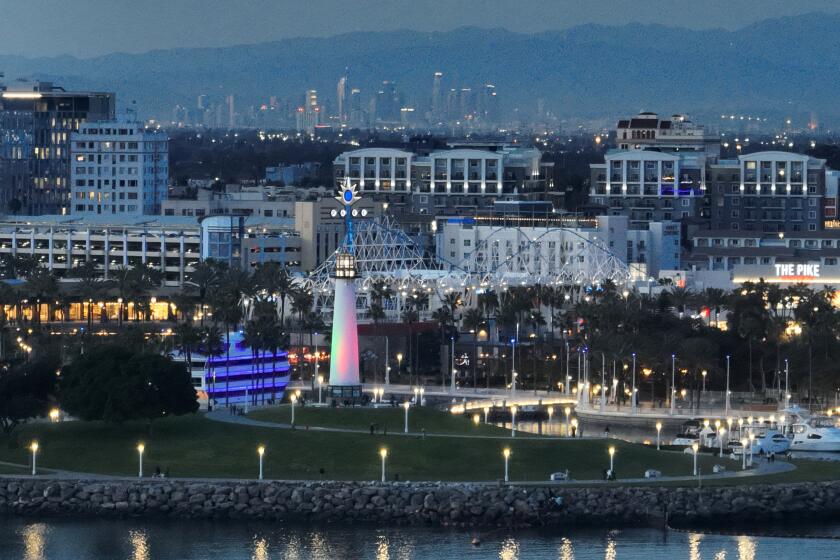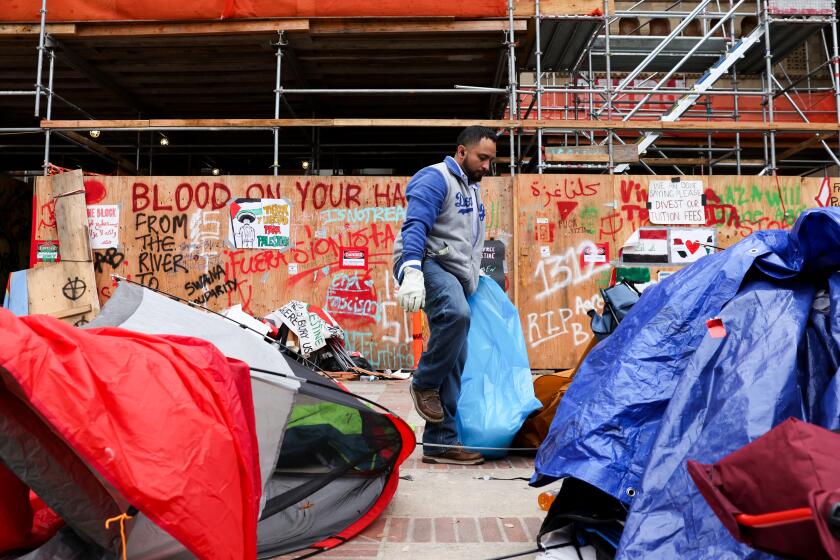COMMENTARY ON DISNEYLAND : Saying ‘Can Do’ to Make New Dream Come True in Anaheim : That attitude enabled the theme park to become a reality in 1955 and can still apply to the proposed expansion.
Working at Disneyland, even for just one summer, creates lifelong memories. If, as in my case, you work for Mickey Mouse for 35 years, you can get pixie dust in the arteries.
To assist in the withdrawal when we leave, some of us formed the Disneyland Alumni Club. It’s open to anyone who has worked there. We now have about 5,300 members. Our motto is “you can take the person out of Disneyland, but you can’t take the Disneyland out of the person.”
Although we may have gone on to new careers, we still have a proprietary interest in any new Disney developments. Currently, many of our members focus their interest on the much publicized Disneyland Resort.
Since I am a fully qualified veteran of the opening days of Disneyland, I am sometimes asked to compare this visionary new development with the original creation of Disneyland.
How can I compare then and now? After all, many of our ex-”Disneylanders,” as we call ourselves, were not even born when Disneyland opened on July 17, 1955.
How can I explain that Disneyland has not always been here, that the Santa Ana Freeway was not completed and that there was no mountain on which to build the Matterhorn? Obviously I can’t.
And yet, if it is true that “the past is prologue to the future,” some history may apply to the future creation of the Disneyland Resort. As I write this, I am amazed at how dumb I was when I accidentally began my Disneyland career.
A friend introduced me to Walt Disney, who hired me to create a training program for the people who would work in this place called “Disneyland,” located in Anaheim, in Orange County, California, U.S.A. I had two questions: “What’s a ‘Disneyland?’ ” You may think this was stupid, but my experience was in making industrial products. I’d never heard of a “Disneyland,” and, I’ll confess, did not know much about Walt Disney. I found out that I would be training people to operate a dream --Disney’s 20-year dream of a place where families could have fun together.
“Why in Anaheim?” was my second question. For anyone who thinks that Anaheim has always been a city of 220,000 people, and one of the world’s most famous recreation centers, this may also seem like an odd question. But not if, as it was for me, Anaheim was a little town of 20,000 people that one would drive through on the way to Los Angeles.
Well, it did have some national recognition: In the days before TV, the Jack Benny Sunday radio program had a regular gag in which a gravelly voiced train conductor would announce a departure for “Anaheim, Azusa and Cucamonga,” with an accent on the “Cuca.”
In the process of conducting a training program for myself, I found that Disney wanted flat land at a reasonable price where he could create his own rivers, mountains and living stories about the America he loved.
Anaheim had other compelling advantages. There was the climate, of course. The uncompleted Santa Ana Freeway would bring guests to the main entrance. And, it was predicted that Orange County would be the fastest-growing area in the nation. As a result, we now have an Orange County--without orange trees.
Although the differences between 1955 and the future Disneyland Resort outweigh similarities, one concern was as great then as it seems to be now: traffic control.
Walt and his brother Roy Disney approved my training program. I was then told that my young assistant could handle the pre-opening training, and that I was to coordinate traffic control--getting people in and out of Disneyland. That young assistant later became my boss for 30 years, and is now chairman of Walt Disney Attractions.
Here again, I was thrown into something I did not know a damned thing about. Fortunately, I had already learned two unwritten laws that are as valid now as they were then:
Walt Disney felt that everything was everyone’s job. You never said (these) four little words: “It’s not my job.”
And Admiral Fowler, who directed the miracles of constructing Disneyland in one year, had a two-word response to any Disney request: “can do.”
As a result, I said “can do” and began to learn some things then that can apply to the exciting future of the Disneyland Resort.
Fortunately, I did not need to know anything about traffic control. The young leaders from the city, county and California Highway Patrol also had a “can-do” approach to any problem, and we had problems.
Anaheim had been basically a farming community, and the small two-lane streets were inadequate for the anticipated crowds.
The community leaders understood Disney’s vision, and I think they would have moved mountains, if there had been any, to help Disneyland open on time.
Yes, there were laws and regulations in 1955. But Disney’s dream of Disneyland infected everyone, and a “can-do” attitude found ways to change or get around most bureaucratic obstacles.
I cannot remember Disney mentioning “the bottom line” as it applies today for making a profit on any activity. Although Disneyland would eventually make tons of money--”the only people trap built by a mouse”--his interest was in creating his dream. He would say that “Disneyland is a work of love. We didn’t go into it just with the idea of making money.”
Although I am a born coward, Disney seemed to thrive on taking risks. For my young friends who think that Disneyland was always a success, it was really one of Disney’s biggest gambles. An original cost of $17 million does not seem like much compared to a few billions, but in 1955 it was a lot of money, and Disney had to hock his insurance to help find the needed cash. He believed in his dream in spite of the fact that, as he pointed out, “some experts predicted that Disneyland would be a Hollywood Spectacular . . . a spectacular failure.”
1955 was one of the rainiest years in Anaheim history, slowing up construction. In addition, we had labor strikes. In spite of these and other problems, we opened one year after groundbreaking.
Although we worked all night before our historic opening, we were not really ready. For example, due to the plumbers’ strike we had to choose between having restrooms or drinking fountains. We chose the restrooms, and guests complained that we were trying to sell soft drinks. We received thousands of complaints, but while complaining, they said they would be back because “the people were so friendly and the park was so clean.”
Since Disney knew that we had a lot to learn, and a lot of things to do, he announced to the world that “Disneyland will never be completed as long as there is imagination left in the world.”
And now the Disneyland Resort is here to prove that prophecy.
I can assure you that I am not going to sit down and read the proposed resort’s 2,300-page environmental impact report, but it is an exciting new dream ... the greatest challenge since the creation of Disneyland.
As it was in the past, and still is today, the investment is a problem. As Disney pointed out, “I could never convince the financiers that Disneyland was feasible, because dreams offer too little collateral.” And look what happened!
I hope that the Disney people, the community and everyone involved will combine resources for the Disneyland Resort and, in spite of the challenges, say “can do.”
More to Read
Start your day right
Sign up for Essential California for news, features and recommendations from the L.A. Times and beyond in your inbox six days a week.
You may occasionally receive promotional content from the Los Angeles Times.






